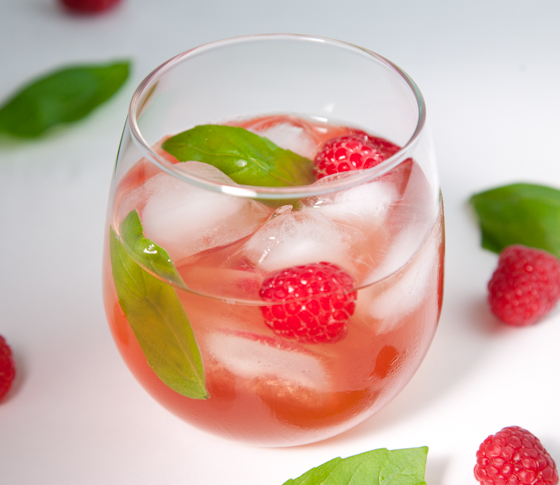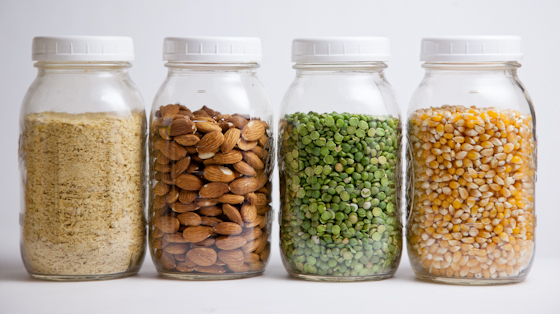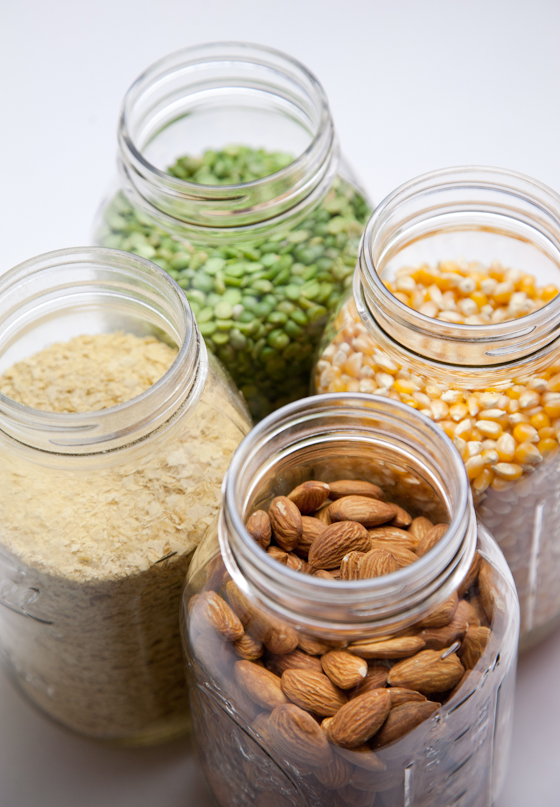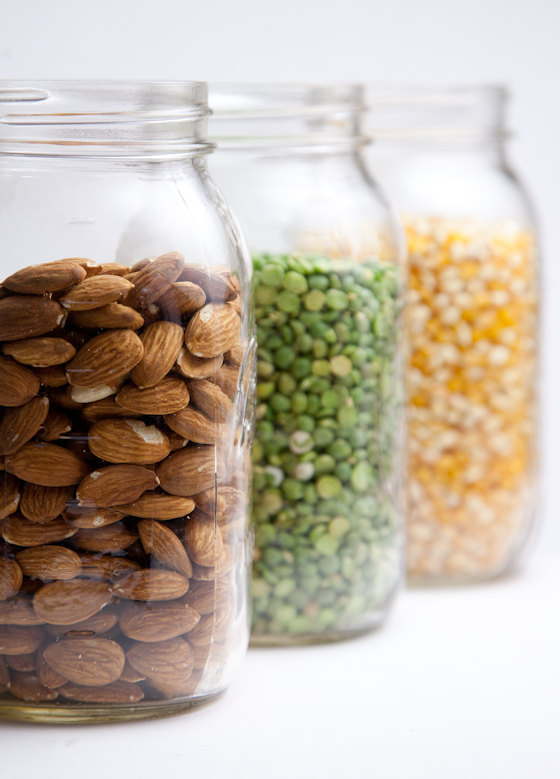My Vegan Pantry Staples
I’ve received a few questions recently about how to stock a vegan pantry. This is one of those things that I think I’ve taken for granted, forgetting that it took me years to develop a well-stocked pantry and get comfortable with a lot of the foods I now enjoy on a daily basis. When you’re making the switch to veganism (or simply switching to more whole, plant-based foods), it’s helpful to see what other people are buying. And even if you’re not new to this style of eating, it’s always nice to expand your regular food repertoire.
This list is by no means comprehensive, but I tried to be thorough and I hope it gives you a general sense of how I stock my pantry. I like to switch things up every so often; however, these are my staples. I recommend buying in bulk if space allows, and choosing organic when available and within budget.
Nuts & Seeds
Raw almonds, walnuts, and pistachios are favorites, and cashews are very versatile when it comes to making desserts, cheese alternatives, and cream sauces. I also use a lot of pumpkin seeds, chia seeds, ground flax, and hemp seeds in smoothies and salads. They’re a great source of protein and healthy fats, and really help to give my meals some staying power. Chia and flax seeds are also particularly useful as egg replacers when it comes to vegan baking. Other must-haves? My beloved raw almond butter and tahini.
Dried Beans/Legumes
Chickpeas, lentils, split peas, black beans, cannellini, aduki…I love them all (well, except kidney beans) and try to mix up what I buy to prevent food ruts. Chickpeas, however, are pretty much always on rotation. It’s much more cost-effective to buy dried versus canned, and I’m now in the habit of soaking bigger batches of beans a couple of times a week (overnight in the fridge). You can also freeze them once cooked.
Seaweed
Kombu for soaking/cooking the dried beans to help with digestion, and dulse flakes for salads (it can be treated as salt, although it’s an acquired taste!). Kelp noodles are a nice (super low-cal, high calcium and iron) option, and I also just recently picked up some sheets of nori to attempt homemade sushi…I’ll report back on that one.
Grains
Gluten-free rolled oats, popcorn (a favorite snack – especially with nutritional yeast or cinnamon), quinoa, millet, and brown rice. I’ve had a mason jar of amaranth forever, and while I like it popped, I’m working up to loving the otherwise earthy flavor. The nutritional stats are awesome, however (really high in iron, protein, and fiber).
Flours, Starches & Gums
Spelt flour is probably my favorite in terms of taste and texture, but it’s not gluten-free. I frequently use blends of brown rice, sorghum, chickpea, and white rice flours, along with potato and tapioca starches to create a lighter texture. I sometimes use xanthan gum as a binding agent for gluten-free baking, as well as to thicken smoothies. Some people have trouble digesting it, but my sensitive stomach seems to be okay with it (knock on wood).

Dried Fruit
Medjool dates are awesome as pre-workout fuel or in raw desserts, as are prunes…because I’m basically a senior citizen. I also like to snack on goji berries and my new love – dried Turkish figs. I actually didn’t like the dried figs the first couple of times I tried them, but now I can’t get enough. It’s worth paying a little more for them at Whole Foods versus Trader Joe’s in terms of taste.
Protein Powder
It’s pricey, but Vega Performance Protein or Vega One (Chai flavor!) are the best tasting, in my opinion. I like the nutritional profile for the Garden of Life raw protein powders too, but I find them to be a little gritty. Usually, I’ll wait until Vitacost is having a sale to stock up on Vega.
Chocolate!
Raw cacao powder & raw cacao nibs are my chocolate of choice. I used to regularly eat the Trader Joe’s chocolate chips by the handful, but that was creating all kinds of annoying sugar cravings for me. I wouldn’t exactly eat raw cacao nibs by the handful, but they satisfy my chocolate cravings when mixed into other desserts.
Oils & Vinegars
Coconut oil for high temp cooking, and hemp oil for raw recipes and hummus (don’t heat this). I occasionally use extra virgin olive oil for temperatures less than 350 degrees F. In terms of vinegars, raw apple cider vinegar is my go-to for everything from hummus (in place of lemon) to salad dressings, but I occasionally use balsamic and rice vinegars depending on what I’m making.
Sweeteners
NuNaturals stevia is my preferred choice flavor-wise (some brands have a terrible aftertaste), but I occasionally use coconut sugar and maple syrup for baking. Date paste is also great (just medjool dates blended with water). I used to buy agave syrup, but the verdict seems to be out on whether that’s any better than other processed sugars. The only time I use regular cane sugar is for my homemade kombucha.

Non-Dairy Milks
Almond is my favorite, and I love light canned coconut milk for homemade ice cream. Full fat coconut milk is incredible for making vegan whipped cream. I like the taste of soy milk, but I figure I eat enough soy in the form of tofu and tempeh.
Canned Goods, Spices & Other
Diced tomatoes, tomato paste, pumpkin puree and applesauce (you can use them in place of oil for baking), and canned beans (in case I forget to soak them in advance). Vegetable broth, particularly the Better Than Bouillon brand, for soups and stews, as well as for giving grains added flavor. Nutritional yeast (an excellent vegan source of B12 and used so often it should probably have its own category), Bragg liquid aminos, hot sauce, and lots of dried spices. I tend to most frequently use cinnamon, nutmeg, cloves, smoked paprika, cumin, chili powder, turmeric (a great natural food coloring too), cayenne, dill, parsley, thyme, oregano, basil, and garlic powder.
Beverages
Green and mint teas are my top picks, and Dandy Blend (an alternative to coffee) is also really good, especially served with almond milk, raw cacao powder, and vanilla stevia. Since I started brewing my own kombucha, I tend to have a glass or two every day.

I won’t go into produce or perishables in this post, but there are a few foods worth noting:
Avocado
Lends a creamy texture to smoothies, chocolate pudding, and even mashed up with some garlic as a sort of Alfredo pasta sauce. I probably enjoy avocado in some form most days. It never gets old.
Vegan Sources of Protein
Organic, non-GMO tofu & tempeh are staples for me, and I typically incorporate them into my meals 2-3 times a week. Seitan is also great if you’re not gluten-free, and it’s surprisingly easy to make your own.
Frozen Bananas
I always have a couple on hand for smoothies and banana ‘soft-serve’. This was sort of life-changing for me when I gave up dairy-based frozen yogurts.
I usually buy things like dried beans and grains from Whole Foods’ bulk bins, flours and specialty ingredients from Vitacost or Amazon, and most other items at Trader Joe’s.
Is there anything you would consider a must-have in a vegan pantry? Where do you tend to do most of your shopping?



